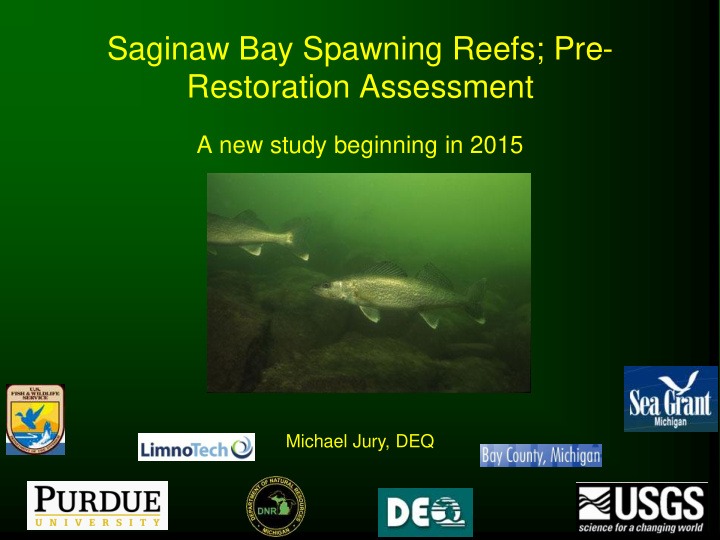



Saginaw Bay Spawning Reefs; Pre- Restoration Assessment A new study beginning in 2015 Michael Jury, DEQ
Historic Walleye Harvest from Saginaw Bay 1000 Commercial Harvest 800 (metric tons) Pre 1945 Ave. ~453.6 Tonnes or about 1 600 million lbs. 400 200 0 1880 1901 1922 1932 1945 1962 Year
Reef restoration for Saginaw Bay first conceived as: • A recovery strategy in the Saginaw Bay walleye recovery plan • A demonstration project
Premise: • Historically the bay’s walleye population was supported by both reef and river spawning fish • Populations hailing from multiple spawning sources are more resilient to perturbation • Walleye recovery should seek to achieve sources and population structure, not just numbers. • Potential benefit for other species too (lake whitefish, lake trout, cisco)
Saginaw Bay Walleye Open Water Angler Catch Rate and Abundance of Walleye from the Gillnet Survey 1994 - 2013 50 0.45 45 0.4 Abundance (gillnet CPUE) Angler CPUE (walleye/hr) 40 0.35 35 0.3 30 0.25 25 0.2 20 0.15 15 0.1 10 0.05 5 0 0 1994 1995 1996 1997 1998 1999 2000 2001 2002 2003 2004 2005 2006 2007 2008 2009 2010 2011 2012 2013 Walleye abundance Alewife abundance Angler CPUE
Background: Inner Bay Reefs From Organ et al. (1979) & Goodyear et al. (1982)
From Fielder (2002)
Study and Proposed Restoration Sites :
Information needed before restoration can begin: • Before we can invest in reef habitat restoration we need to know: – The full status of remaining historic reef habitat in the inner bay. There is still some remnant habitat, what shape is it in? – What’s spawning there? – What is the condition of the proposed restoration sites? Basically we need a “before” look at things.
Specific study objectives: • Obj. 1: Determine habitat suitability of remnant outer bay and proposed inner bay reef sites by assessing substrate conditions, water quality and potential egg predators. • Obj. 2: Evaluate reproductive usage by adult fish during both the spring and fall spawning periods. • Obj. 3: Assess the genetic and phenotypic characteristics of the Saginaw Bay walleye and lake whitefish populations. • Obj. 4: Develop and execute a plan to engage local stakeholders in Saginaw Bay reef restoration.
Sedimentation Model-Predicted Deposition (2009) 11
Follow up work will be to propose two reefs for restoration: • Conceptually: • Each 0.4 ha in area and 1 m in relief • Each reef will amount to 4,000 m 3 of material • 25% cobble, 75% gravel, native material, glacial till • Placement by barge and crane • New effective depth of 1.4 – 2.2 m post construction
Some of the field work involved in this study: • Sedimentation and hydrodynamic model predictions to refine reef placement • Spring and fall evaluations • Gillnet collections (spawners) and egg collections (spring pumping and fall traps) • Genetic analysis • Microzone water quality monitoring • Visual inspection and side scan habitat mapping
Example of Side Scan Sonar Mapping
Purdue Research Boat
Egg Sampling on Reefs
Netting to Sample for Evidence of Spawners
Preparing to Set a Net
Retrieving a Net
A Nice Whitefish
Some of the Day’s Catch
The End of a Productive Day
Evaluating the Catch
There’s Always Paperwork to do
Genetic Analysis of Spawners
Timeline: 2015 2016 Funding provided by The Great Lakes Fish & Wildlife Restoration Act and project partners.
Recommend
More recommend